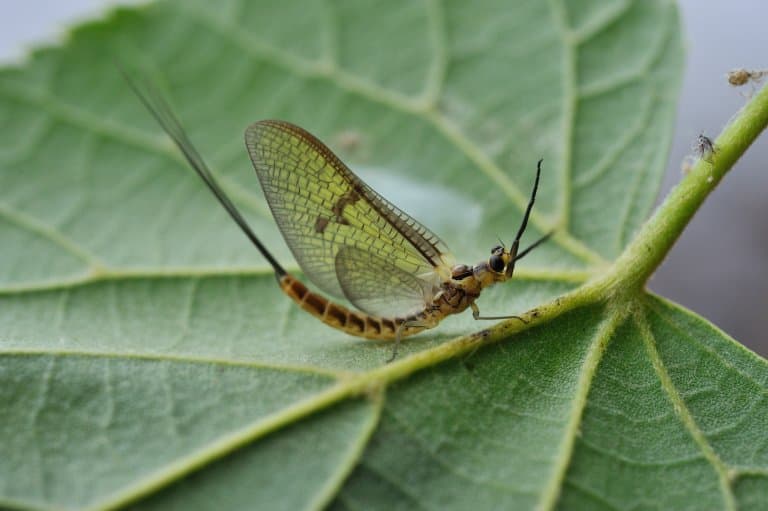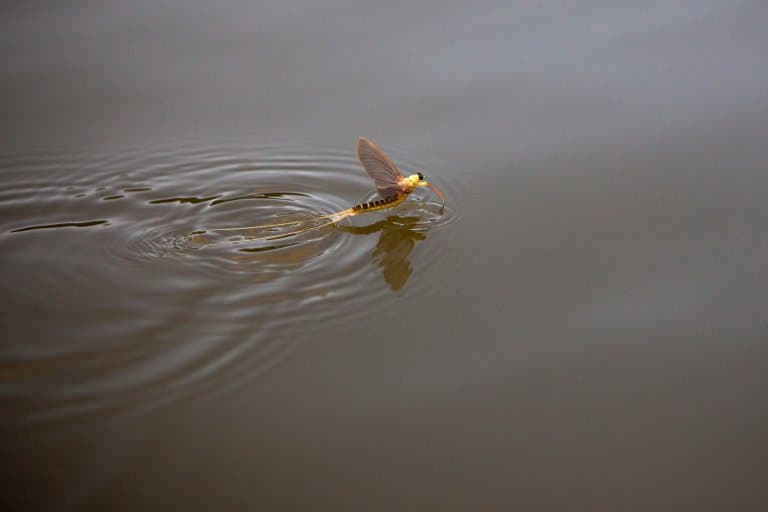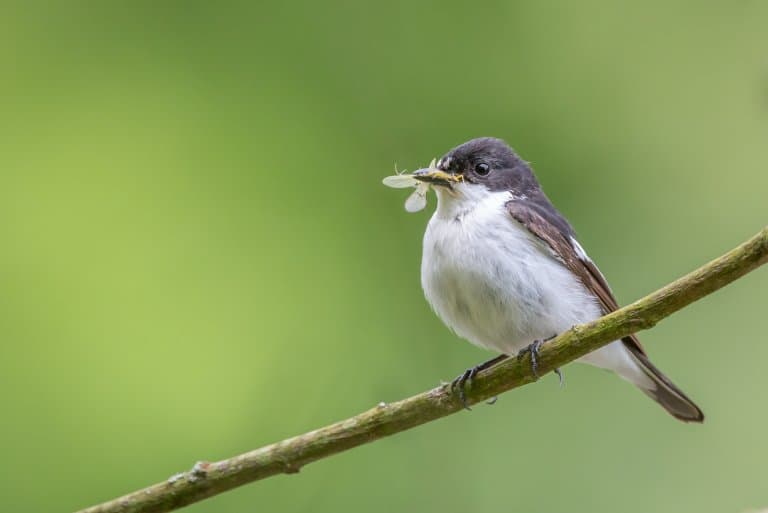Mayfly Profile
Many of the animals we take for granted have some of the most impressive histories. We all know that sharks have been around for hundreds of millions of years and that birds are the surviving dinosaurs, but some of the most common and prolific animals are also ancient.
Palaeoptera refers to the “old wings”. The insects that were in charge long before the dinosaurs were invented. Three lineages are agreed-upon. The dragonflies, the damselflies, and the Mayflies.
Mayflies are aquatic insects known as shadflies (or fishflies in Canada), that are distributed all over the world in clean freshwater habitats, except Antarctica.

Mayfly Facts Overview
| Habitat: | Freshwater streams, under rocks, in sediment |
| Location: | Worldwide except Antarctica |
| Lifespan: | Between a few weeks and several years |
| Size: | Up to around 3cm (1.2 inches) |
| Weight: | <1g |
| Color: | Usually plain grey or brown |
| Diet: | Some are carnivorous, some eat algae or plants |
| Predators: | Birds, dragonflies, fish, amphibians, spiders, insects – everything |
| Top Speed: | Slow |
| No. of Species: |
More than 3,000 |
| Conservation Status: |
Least Concern to Critically Endangered such as Tasmanophlebi lacuscoerulei |
There are more than 3,000 species of mayfly, that belong to over 400 genera in 42 families.
They seem to be the first choice of food for every insect-eating animal. They’re a great source of nutrients for thousands of species, and as such they need to compensate.
Females lay thousands of eggs and nymphs gather in high concentrations and diversity in the sediment of freshwater streams all over the world.
Despite their reputation, these nymphs live for many months, sometimes years, emerging as adults to restart the cycle. This late stage is notoriously short; sometimes only lasting minutes.
While most known species are doing well, they are sensitive to climatic and water composition changes, and we’ve already lost some to climate change.
Interesting Mayfly Facts
1. They don’t only live for a day
Like the crane fly, or “daddy long legs”, Mayflies are another victim of the rumour of a painfully short life. In both cases, the rumour comes from the fact that the adult stage isn’t around for long.
Even the scientific name for the order, ephermeroptera, means short-lived winged (animal). But the majority of these insects’ lives are spent under the water as nymphs.
This stage can even last for years in many species, and some of these nymphs are cute. They look like tiny sea turtles or horseshoe crabs. Others look more creepy, like walking shrimp.
Once they reach maturity, they emerge from the water to mate, and will often die not long afterwards. In one species in particular, it’s not long at all.
The adult stage of female Dolania americana only lasts for about 5 minutes before they mate, lay eggs and die. This might make it the shortest-lived breeding stage on Earth. But despite this, they’ve done alright for themselves. 1

2. They’re ancient
If you’ve ever seen one of those fossils of a giant dragonfly, you might know that this group of insects has been around for a while. Somewhere close to 300 million years ago, insects like this ruled the Earth.
The largest known so far was a dragonfly the size of a crow: 75cm across and weighed half a kilo. But mayflies were around in the fossil record at this time, too.
Recognisable mayfly fossils date back as far as 323 million years ago.
3. Species are determined by their penises
Of the 3,000 species or so, many can be hard to tell apart. Entomologists are well known for being heavily penis-oriented, and Mayfly identification is no exception.
To tell them apart, just look at the male genitalia. Each species has a unique style that sets them apart from the rest. The hard part is getting them to show it to you. 2

4. They’re the only insect to moult after growing wings
There are four stages to the mayfly’s life cycle: Egg, nymph, subimago (subadult) and imago (adult).
Many insects that have a cycle of moulting and nymph stages only present with wings in their final stage. Mantids, crickets, and many others are good examples of this.
Mayflies are the only insect left that has two adult stages and thus will moult even after growing a pair of fully-functioning wings. This is thought to be a primitive feature of early insects and one that doesn’t exist anywhere else any longer.
5. They’re eaten by everything
Mayflies make up a large amount of the caloric requirements for almost every type of animal. Bats, birds, lizards, amphibians, fish, and other insects and crustaceans will eat them if given the chance.
This makes them critically important to the nutrient recycling of the freshwater ecosystems, and may explain why as adults there isn’t much point in evolving a longer life. As a buffer against relentless predation, female mayflies may lay up to three thousand eggs in one go.
Despite being a universal food source, these are exceptionally successful animals. Not only have they outlasted almost all other animals around, they’re cosmopolitan and diverse, as well as hugely prolific.
The order occupies every continent except Antarctica (almost nothing lives there), and a single square foot of gravel-bottomed stream can house 1,400 nymphs across 33 species.
They’re so desired as a food source many of the most common flies tied as lures by fishermen out of feathers are based on this insect. 3

6. They’re referred to in the oldest texts
The Epic of Gilgamesh predates Homer by several centuries and is one of the oldest written stories we have.
It chronicles the life of a Babylonian ruler from 2700 BC, and references the mayfly as a metaphor for the ephemeral nature of our own existence. 4
7. They emerge all year round, despite their name
Despite the common name, Mayflies aren’t restricted to the Month of May. Some species are, and that’s likely where the name originated, but the majority emerge at all times of the year.
In some places, stoneflies and caddisflies are included in the name, making it a bit of a catch-all for any number of similarly-aquatic freshwater flying insects.

8. Some species are endangered
Being aquatic invertebrates, mayflies are sensitive to changes in water quality. Some species have already gone extinct in recent years, such as Pentagenia robusta which was thought to occupy the Ohio River area, and was killed off as a result of increasing sedimentation and reduced flow.
In Australia, the Large Blue Lake Mayfly is listed as critically endangered for similar reasons, including a reduction in rainfall and an increase in temperatures attributed to climate change. 5
9. They are a tourist attraction
“Tisza blooming”, the hatch of the enormous mayfly species ‘Palingenia longicauda’, is a popular tourist attraction in Serbia and Hungary every year in June.
10. We eat them too
It’s not just animals that eat mayfly, they are also eaten in several human cultures, such as in China and Japan.
In Malawi a paste of mayflies and mosquitoes (known as ‘Caenis kungu’) is made into a cake!
Food experts estimate they contain more protein than any other edible insect of the same weight.
Yum!
Mayfly Fact-File Summary
Scientific Classification
| Kingdom: | Animalia |
| Phylum: | Arthropoda |
| Class: | Insecta |
| Order: | Ephemeroptera |
| Family: | 42 families |
Fact Sources & References
- Craig H. Welch (1998), “Book Of Insect Records, Chapter 37: Shortest Reproductive Life“, University of Florida.
- Justin W. Leonard, “Mayfly Form and Function“, Britannica.
- Justin W. Leonard, “Mayfly“, Britannica.
- Craig Macadon (2011), “The curious history of the mayfly“, The Freshwater Blog.
- “Large Blue Lake Mayfly“, IUCN Red List.
